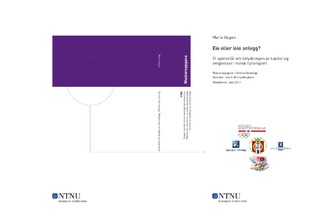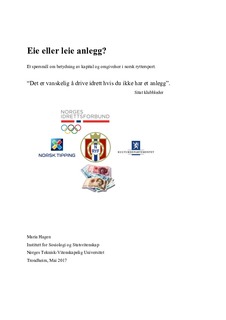| dc.description.abstract | In this study, I seek to investigate the importance of capital and surroundings when it comes to equestrian sport facilities in Norway. Whether one should own or rent facilities seems to have increased in relevance over time. Equestrian sport has during the last decades increased significantly when it comes to memberships and popularity. With growing popularity comes also an increasing demand for facilities. On that note several commercial actors interest has seen the growing opportunity of equestrian sport as an opportunity to capitalize on the equestrian society. The national equestrian federation (NRYF) has expressed concern that this development may the impede on equestrian sports club´s opportunity to build their own facilities. The study wants to investigate club leaders’ experiences when it comes to the importance of capital and surroundings, and how these factors relate to opportunities and limitations in regards to sports facilities. The empirical framework consists primarily of documents related to public sports policies and subsidies along with previous research on the topic in question.
The theoretical framework of the study is based on Bourdieu´s concepts related to capital and power, and the New Public Management reform program. These are used in the analysis of the importance of capital and surroundings in equestrian sport. This study employs a qualitative research method, primarily based on interviews. The informants are three leaders of different equestrian clubs, all with different business models, one in cooperation with a private equestrian center, one with its own facilities and one with a riding school and own facilities. In addition, it has been conducted a survey of facilities, riding schools and official cooperation with commercial actors among equestrian club´s in Norway (table 2 & 3). The key findings in the study is that social capital seem important for construction of equestrian arenas and for distribution of financial support. This seems to be the case at both local and national level (Bergsgaard, Nødland, & Seippel, 2009; Nenseth, 2009; Rafoss, 2015; Aakvaag, 2008). This supports previous findings in this field of research. The existing research on sport facilities today shows that there are geographical differences when it comes to equestrian centers, riding schools and private partnerships (table 2). These findings can be understood in the context of the importance of capital and environment. Another key finding is that fewer and larger clubs seems to be something the associations should consider for the future, based on the large number of inactive clubs (Table 2). and through interview with club leaders. In summary, the study shows that capital and surroundings can both be limiting for the equestrian clubs, but also create opportunities for facilities in equestrian sport. | nb_NO |

